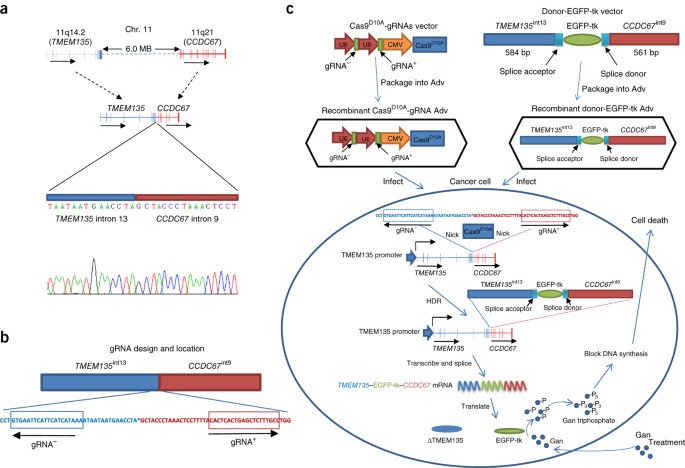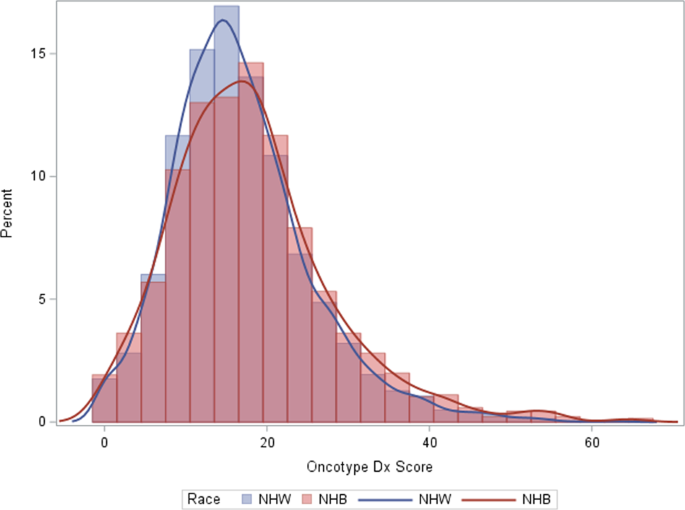
- Select a language for the TTS:
- UK English Female
- UK English Male
- US English Female
- US English Male
- Australian Female
- Australian Male
- Language selected: (auto detect) - EN
Play all audios:
ABSTRACT Specifically targeting genomic rearrangements and mutations in tumor cells remains an elusive goal in cancer therapy. Here, we used Cas9-based genome editing to introduce the gene
encoding the prodrug-converting enzyme herpes simplex virus type 1 thymidine kinase (HSV1-tk) into the genomes of cancer cells carrying unique sequences resulting from genome rearrangements.
Specifically, we targeted the breakpoints of _TMEM135–CCDC67_ and _MAN2A1–FER_ fusions in human prostate cancer or hepatocellular carcinoma cells _in vitro_ and in mouse xenografts. We
designed one adenovirus to deliver the nickase Cas9D10A and guide RNAs targeting the breakpoint sequences, and another to deliver an EGFP-HSV1-tk construct flanked by sequences homologous to
those surrounding the breakpoint. Infection with both viruses resulted in breakpoint-dependent expression of EGFP-tk and ganciclovir-mediated apoptosis. When mouse xenografts were treated
with adenoviruses and ganciclovir, all animals showed decreased tumor burden and no mortality during the study. Thus, Cas9-mediated suicide-gene insertion may be a viable genotype-specific
cancer therapy. Access through your institution Buy or subscribe This is a preview of subscription content, access via your institution ACCESS OPTIONS Access through your institution Access
Nature and 54 other Nature Portfolio journals Get Nature+, our best-value online-access subscription $29.99 / 30 days cancel any time Learn more Subscribe to this journal Receive 12 print
issues and online access $209.00 per year only $17.42 per issue Learn more Buy this article * Purchase on SpringerLink * Instant access to full article PDF Buy now Prices may be subject to
local taxes which are calculated during checkout ADDITIONAL ACCESS OPTIONS: * Log in * Learn about institutional subscriptions * Read our FAQs * Contact customer support SIMILAR CONTENT
BEING VIEWED BY OTHERS HIGH-EFFICIENCY TRANSGENE INTEGRATION BY HOMOLOGY-DIRECTED REPAIR IN HUMAN PRIMARY CELLS USING DNA-PKCS INHIBITION Article 03 August 2023 IN VIVO CRISPR/CAS9 TARGETING
OF FUSION ONCOGENES FOR SELECTIVE ELIMINATION OF CANCER CELLS Article Open access 08 October 2020 EFFICIENT VIRAL DELIVERY OF CAS9 INTO HUMAN SAFE HARBOR Article Open access 08 December
2020 REFERENCES * Hanahan, D. & Weinberg, R.A. Hallmarks of cancer: the next generation. _Cell_ 144, 646–674 (2011). Article CAS Google Scholar * Yu, Y.P. et al. Novel fusion
transcripts associate with progressive prostate cancer. _Am. J. Pathol._ 184, 2840–2849 (2014). Article CAS Google Scholar * Mojica, F.J., Díez-Villaseñor, C., García-Martínez, J. &
Soria, E. Intervening sequences of regularly spaced prokaryotic repeats derive from foreign genetic elements. _J. Mol. Evol._ 60, 174–182 (2005). Article CAS Google Scholar * Jinek, M. et
al. A programmable dual-RNA-guided DNA endonuclease in adaptive bacterial immunity. _Science_ 337, 816–821 (2012). Article CAS Google Scholar * Esvelt, K.M., Smidler, A.L., Catteruccia,
F. & Church, G.M. Concerning RNA-guided gene drives for the alteration of wild populations. _eLife_ 3, 03401 (2014). Article Google Scholar * Ran, F.A. et al. Double nicking by
RNA-guided CRISPR Cas9 for enhanced genome editing specificity. _Cell_ 154, 1380–1389 (2013). Article CAS Google Scholar * Smith, K.O., Galloway, K.S., Kennell, W.L., Ogilvie, K.K. &
Radatus, B.K. A new nucleoside analog, 9-[[2-hydroxy-1-(hydroxymethyl)ethoxyl]methyl]guanine, highly active _in vitro_ against herpes simplex virus types 1 and 2. _Antimicrob. Agents
Chemother._ 22, 55–61 (1982). Article CAS Google Scholar * Van Rompay, A.R., Johansson, M. & Karlsson, A. Phosphorylation of nucleosides and nucleoside analogs by mammalian nucleoside
monophosphate kinases. _Pharmacol. Ther._ 87, 189–198 (2000). Article CAS Google Scholar * Yu, Y.P. et al. Genomic copy number variations in the genomes of leukocytes predict prostate
cancer clinical outcomes. _PLoS One_ 10, e0135982 (2015). Article Google Scholar * Luo, J.H. et al. Discovery and classification of fusion transcripts in prostate cancer and normal
prostate tissue. _Am. J. Pathol._ 185, 1834–1845 (2015). Article CAS Google Scholar * Ohnuki, Y., Marnell, M.M., Babcock, M.S., Lechner, J.F. & Kaighn, M.E. Chromosomal analysis of
human prostatic adenocarcinoma cell lines. _Cancer Res._ 40, 524–534 (1980). CAS PubMed Google Scholar * Bernardino, J. et al. Characterization of chromosome changes in two human
prostatic carcinoma cell lines (PC-3 and DU145) using chromosome painting and comparative genomic hybridization. _Cancer Genet. Cytogenet._ 96, 123–128 (1997). Article CAS Google Scholar
* Chen, Z.H. et al. MAN2A1-FER fusion gene is expressed by human liver and other tumor types and has oncogenic activity in mice. _Gastroenterology_
http://dx.doi.org/10.1053/j.gastro.2016.12.036 (2017). * Hanahan, D. & Weinberg, R.A. The hallmarks of cancer. _Cell_ 100, 57–70 (2000). Article CAS Google Scholar * Yu, C. et al.
Small molecules enhance CRISPR genome editing in pluripotent stem cells. _Cell Stem Cell_ 16, 142–147 (2015). Article CAS Google Scholar * Hsu, P.D. et al. DNA targeting specificity of
RNA-guided Cas9 nucleases. _Nat. Biotechnol._ 31, 827–832 (2013). Article CAS Google Scholar * Cong, L. et al. Multiplex genome engineering using CRISPR/Cas systems. _Science_ 339,
819–823 (2013). Article CAS Google Scholar * Kozarsky, K.F. & Wilson, J.M. Gene therapy: adenovirus vectors. _Curr. Opin. Genet. Dev._ 3, 499–503 (1993). Article CAS Google Scholar
* Anderson, R.D., Haskell, R.E., Xia, H., Roessler, B.J. & Davidson, B.L. A simple method for the rapid generation of recombinant adenovirus vectors. _Gene Ther._ 7, 1034–1038 (2000).
Article CAS Google Scholar * Wang, H. et al. p53-induced gene 3 mediates cell death induced by glutathione peroxidase 3. _J. Biol. Chem._ 287, 16890–16902 (2012). Article CAS Google
Scholar * Zhu, Z.H. et al. Integrin alpha 7 interacts with high temperature requirement A2 (HtrA2) to induce prostate cancer cell death. _Am. J. Pathol._ 177, 1176–1186 (2010). Article CAS
Google Scholar * Luo, K.L., Luo, J.H. & Yu, Y.P. (−)-Epigallocatechin-3-gallate induces Du145 prostate cancer cell death via downregulation of inhibitor of DNA binding 2, a dominant
negative helix-loop-helix protein. _Cancer Sci._ 101, 707–712 (2010). Article CAS Google Scholar * Han, Y.C. et al. Interaction of integrin-linked kinase and miniature chromosome
maintenance 7-mediating integrin alpha7 induced cell growth suppression. _Cancer Res._ 70, 4375–4384 (2010). Article CAS Google Scholar * Zhu, Z.H., Yu, Y.P., Shi, Y.K., Nelson, J.B.
& Luo, J.H. CSR1 induces cell death through inactivation of CPSF3. _Oncogene_ 28, 41–51 (2009). Article CAS Google Scholar * Shi, Y.K., Yu, Y.P., Tseng, G.C. & Luo, J.H.
Inhibition of prostate cancer growth and metastasis using small interference RNA specific for minichromosome complex maintenance component 7. _Cancer Gene Ther._ 17, 694–699 (2010). Article
CAS Google Scholar * Yu, Y.P. et al. Glutathione peroxidase 3, deleted or methylated in prostate cancer, suppresses prostate cancer growth and metastasis. _Cancer Res._ 67, 8043–8050
(2007). Article CAS Google Scholar * Ren, B. et al. Analysis of integrin alpha7 mutations in prostate cancer, liver cancer, glioblastoma multiforme, and leiomyosarcoma. _J. Natl. Cancer
Inst._ 99, 868–880 (2007). Article CAS Google Scholar * Yu, G. et al. CSR1 suppresses tumor growth and metastasis of prostate cancer. _Am. J. Pathol._ 168, 597–607 (2006). Article CAS
Google Scholar * Maruyama, T. et al. Increasing the efficiency of precise genome editing with CRISPR-Cas9 by inhibition of nonhomologous end joining. _Nat. Biotechnol._ 33, 538–542 (2015).
Article CAS Google Scholar * Han, Y.C. et al. Metallothionein 1 h tumour suppressor activity in prostate cancer is mediated by euchromatin methyltransferase 1. _J. Pathol._ 230, 184–193
(2013). Article CAS Google Scholar * Ren, B. et al. MCM7 amplification and overexpression are associated with prostate cancer progression. _Oncogene_ 25, 1090–1098 (2006). Article CAS
Google Scholar * Jing, L. et al. Expression of myopodin induces suppression of tumor growth and metastasis. _Am. J. Pathol._ 164, 1799–1806 (2004). Article CAS Google Scholar * Demetris,
A.J., Seaberg, E.C., Wennerberg, A., Ionellie, J. & Michalopoulos, G. Ductular reaction after submassive necrosis in humans: special emphasis on analysis of ductular hepatocytes. _Am.
J. Pathol._ 149, 439–448 (1996). CAS PubMed PubMed Central Google Scholar * Yu, Y.P. et al. Whole-genome methylation sequencing reveals distinct impact of differential methylations on
gene transcription in prostate cancer. _Am. J. Pathol._ 183, 1960–1970 (2013). Article CAS Google Scholar * Lin, F. et al. Myopodin, a synaptopodin homologue, is frequently deleted in
invasive prostate cancers. _Am. J. Pathol._ 159, 1603–1612 (2001). Article CAS Google Scholar Download references ACKNOWLEDGEMENTS We thank S. Zheng for technical support. This work was
supported by grants from the National Cancer Institute to JHL (RO1 CA098249 to J.-H.L.), the Department of Defense (W81XWH-16-1-0364) to J.-H.L. and the University of Pittsburgh Cancer
Institute to J.-H.L., G.K.M. and J.B.N. AUTHOR INFORMATION AUTHORS AND AFFILIATIONS * Department of Pathology, University of Pittsburgh School of Medicine, Pittsburgh, Pennsylvania, USA
Zhang-Hui Chen, Yan P Yu, Ze-Hua Zuo, George K Michalopoulos, Satdatshan Monga & Jian-Hua Luo * Department of Urology, University of Pittsburgh School of Medicine, Pittsburgh,
Pennsylvania, USA Joel B Nelson * Department of Biostatistics, University of Pittsburgh School of Medicine, Pittsburgh, Pennsylvania, USA Silvia Liu & George Tseng Authors * Zhang-Hui
Chen View author publications You can also search for this author inPubMed Google Scholar * Yan P Yu View author publications You can also search for this author inPubMed Google Scholar *
Ze-Hua Zuo View author publications You can also search for this author inPubMed Google Scholar * Joel B Nelson View author publications You can also search for this author inPubMed Google
Scholar * George K Michalopoulos View author publications You can also search for this author inPubMed Google Scholar * Satdatshan Monga View author publications You can also search for this
author inPubMed Google Scholar * Silvia Liu View author publications You can also search for this author inPubMed Google Scholar * George Tseng View author publications You can also search
for this author inPubMed Google Scholar * Jian-Hua Luo View author publications You can also search for this author inPubMed Google Scholar CONTRIBUTIONS J.-H.L. and Y.P.Y. conceived the
concept of the project and devised the research strategy. Z.-H.C. and Z.-H.Z. performed most experiments, S.M. provided materials, G.K.M. and J.B.N. provided expertise and advice on the
biology of and therapies for liver cancer and prostate cancer. S.L. and G.T. performed biostatistics and bioinformatics analyses. CORRESPONDING AUTHOR Correspondence to Jian-Hua Luo. ETHICS
DECLARATIONS COMPETING INTERESTS The authors declare no competing financial interests. SUPPLEMENTARY INFORMATION SUPPLEMENTARY TEXT AND FIGURES Supplementary Figures 1–3 and Supplementary
Tables 1–7 (PDF 1593 kb) RIGHTS AND PERMISSIONS Reprints and permissions ABOUT THIS ARTICLE CITE THIS ARTICLE Chen, ZH., Yu, Y., Zuo, ZH. _et al._ Targeting genomic rearrangements in tumor
cells through Cas9-mediated insertion of a suicide gene. _Nat Biotechnol_ 35, 543–550 (2017). https://doi.org/10.1038/nbt.3843 Download citation * Received: 30 June 2016 * Accepted: 08 March
2017 * Published: 01 May 2017 * Issue Date: June 2017 * DOI: https://doi.org/10.1038/nbt.3843 SHARE THIS ARTICLE Anyone you share the following link with will be able to read this content:
Get shareable link Sorry, a shareable link is not currently available for this article. Copy to clipboard Provided by the Springer Nature SharedIt content-sharing initiative








